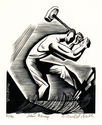
19th, 20th & 21st Century Fine Prints
707-546-7352 · fax 707-546-7924 · web: www.annexgalleries.com · email: artannex@aol.com
Bernard Brussel-Smith Biography
Bernard Brussel-Smith
American
1914–1989
Biography
Woodengraver Bernard Brussel-Smith was born in Greenwich Village, New York in 1914. He pursued studio arts at the Pennsylvania Academy of Fine Arts from 1931-1936, studying lithography with Roy Cleveland Nurse (1885-1975) and Henry McCarter (1876-1955). He later discovered engraving when he attended courses at the New School for Social Research in New York, studying under woodengraver Fritz Eichenberg beginning in 1941. He proved adept at the precise medium, and Eichenberg soon elected him for the position of teacher's assistant. Woodengraving would become Brussel-Smith's preferred medium for the next five decades.
From 1957 to 1958 he studied with famed Atelier 17 founder and printmaker Stanley William Hayter in France, on a Cresson Fellowship. There, he worked with the experimental techniques that Hayter and Joan Miro were developing to recreate the processes used by William Blake. Brussel-Smith gained inspiration from his surroundings there, and he would return to the south of France every year, summering with his family in Collonges-la-Rouge, a village whose architecture and landscapes would become a recurring theme in his work.
Brussel-Smith supported himself through work as a commercial artist and illustrator, and was hired by publications such as Life, Reader's Digest, Time and The Saturday Evening Post, as well as major corporations including Seagram's and the pharmaceutical company Smith, Kline & French (now GlaxoSmithKline). Among his most well-known commercial works was a series for the New York Auto Show in the 1950s and '60s. However, his commissioned work was not always relegated to commerce. His fine art pieces often depicted the lives of ordinary citizens--on the subway, in the city and countryside, sailors, fishermen, street musicians, railroad workers--and his work became synonymous with American working-class life. In 1947 he was commissioned by the Thomas Crowell Company to illustrate the folk songbook "Sing of America".
He lived for most of his life in New York City, and he taught at the Brooklyn Museum, Cooper Union, City College, and at the National Academy, where in 1952 he was elected an Associate Member. He died in Bedford Hills, NY, in 1988.
Solo exhibitions include Galerie St. Jaques (Collognes-la-Rouge, France), Musee Ernest-Rupin (Brive, France); Olthuysen Atelier (Rotterdam); Desert Museum (Palm Springs, CA); and Bethesda Art Gallery (MD). Retrospectives of his work include the Farleigh Dickenson University Library (1983); the Sterling Memorial Library of Yale University (1988), and the Associated American Artists. His works included in the collections of the Library of Congress, the Philadelphia Museum of Art, New York Public Library, the National Academy of Design, as well as the Boymans Museum in Rotterdam and the Lenin Library in Moscow, among others.



